We may earn revenue from the products available on this page and participate in affiliate programs.
Pink-washed bedrooms accented by gauzy lavender curtains. Rosy armchairs that look like they were concocted out of bunched-up flowers, situated in the middle of a cave. Living rooms filled with Faye Toogood goodies. In real life, creating any one of these places would cost thousands. But in the digital world, there is no budget; designers can let their imaginations run wild.
No fake-looking 3-D renderings and mock-ups here; this field has bred some of the most interesting—and believable—spaces on the Internet. Somewhere between paintings and high-end catalog shoots, these rooms are so exquisitely detailed that you feel like you could just walk on in—and it’s all thanks to Instagram.
“We’re living in a digital era,” says Carlos Neda, a Honduras-based designer. Andrés Reisinger, a multidisciplinary talent from Barcelona, agrees: “Instagram erases any friction. My creative process goes directly to the people who appreciate it.”
On the platform, the designers are free to experiment with materials that don’t exist and with landscapes that would send National Geographic into hysterics (exhibit A: Neda’s reimagining of a Claude Monet sunset). They create sets for brands that might have otherwise hired a traditional stylist and photographer. While it’s too soon to make sweeping generalizations and dub these renderings the future of design, this new generation of artists is definitely making waves—so we had to get to know them better. At the very least, they’ll add a dose of otherworldly wonder to your morning social media scroll.
The Dream Home Mood-Board Maker
Javier Wainstein; Buenos Aires, Argentina

Known for: Creating intricate interiors that name-check big brands and make you feel like you could actually live in them—for a hefty price, of course.
On how he got started: “I studied industrial design at university but discovered a much freer place to play within the 3-D industry. It’s a new movement—sites like Instagram help to promote your work and be seen by people around the world. I’ve had it for less than two years, and it’s amazing the scope social media has.”
On what he tells other people he does: “I explain ideas through computer-generated images. In a way, I shape a small part of the future.”
On the highs: “You can put a moon inside of a living room—that is something quite unique.”
On the lows: “You have to be constantly aware of the latest software and tools related to the production of 3-D images to make your production more efficient day by day.”
On his favorite project: “One of my favorites is a recent collaboration with Danish Studio Overgaard & Dyrman for its new Circle chair. I’d always loved the brand’s work, so when they reached out to me it was really great.”
The Candy-Colored Confectioner
Carlos Neda; Tegucigalpa, Honduras

Known for: A mix of pastel landscapes and interiors—think: a Barbie’s Dream House for the Instagram age.
On how he got started: “I wanted to be a filmmaker, but I didn’t have the money to purchase equipment or the support to make the ideas I had in mind. Digitally, there are no limits in terms of creating a space or object.”
On what he tells other people he does: “I’m a storyteller and world creator. Usually, when people see my work, they want to be part of those spaces and live in them.”
On the upside of Instagram: “I’ve worked with people I have admired for a long time, which is quite surreal to me, coming from a small country.”
On his favorite project: “I actually have two: the first is a video game I’m still working on, based on a Victorian manor. I’m part of the art direction team and I’m the set designer. The second is a collaboration I did with Andrés Reisinger called An Exercise in Creating Space. I learned so much about space, color, form, and simplification with the pieces we created.”
The Avant-Garde Artist
Andrés Reisinger; Barcelona, Spain

Known for: A blend of Surrealist rooms and textural furniture pieces. (He’s one of the biggest names in the game.)
On how he got started: “I needed to create my own rules to play by: I was born in the ’90s in an immigrant town called Hurlingham in Buenos Aires. My parents never bought me any coloring books—instead, they taught me how to draw from scratch. It’s the best thing someone can do for you at a young age, giving you the tools and not the final product. Eventually, when I was 18, I was introduced to 3-D tools by a friend of mine who was studying architecture. From that moment on I’ve been playing with software day and night.”
On what he tells other people he does: “I’m a designer with digital tools.”
On choosing digital over traditional projects: “In the physical world, you’re limited by borders and you begin to think only of objects that can be developed. With digital tools, there are no limits. I can create whatever I want using unpredictable shapes.”
On the advice that stuck: “A product designer–musician friend of mine, Marco Sanguinetti, once told me that all designers should live 400 years in order to practice every design discipline. I know I’m not going to live 400 years, so I try to push the boundaries of all mediums.”
See more about technology in design: IKEA’s Gunrid Curtain Will Purify the Air in Your Home This Cool Terracotta Lamp Doubles as a Vegetable Garden The Coolest New Sheets Are Made With Ultrasonic Tech and Natural Dyes
